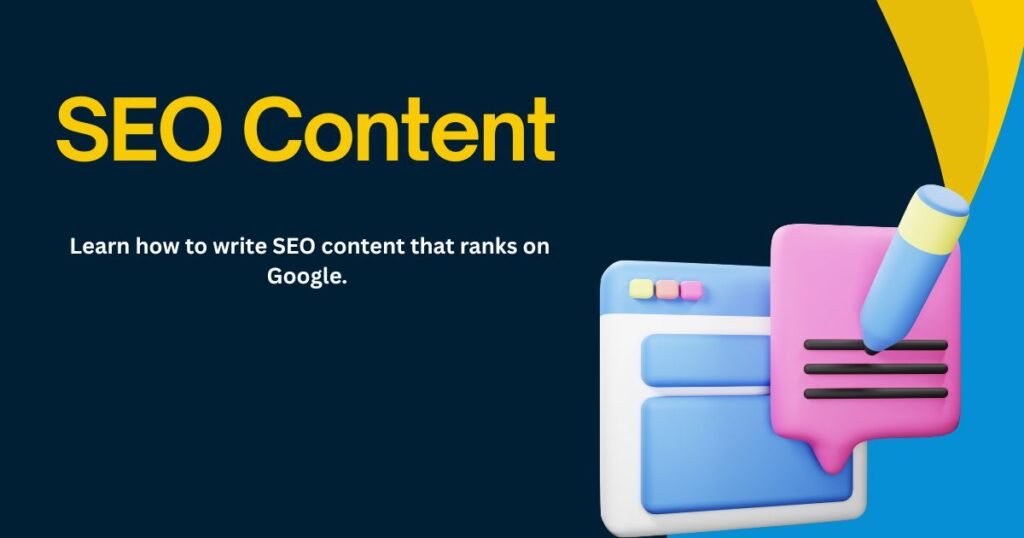How to Create SEO Content That Drives Results

Search engine optimization (SEO) isn’t just a buzzword; it’s an essential part of a successful digital marketing strategy. However, creating SEO content that ranks high in search engine results pages (SERPs) and engages readers can feel like navigating a maze without a map. What exactly does SEO content entail? Why does it matter? And how can you do it effectively?
This blog will break it all down for you, step by step. Whether you’re an SEO newbie or a seasoned marketer, you’ll learn the essential techniques to create content that ranks well, attracts traffic, and keeps your audience coming back for more.
Understanding SEO Content
What is SEO Content?
SEO content is any type of digital content that is created with the ultimate purpose of driving organic traffic from search engines. It encompasses blog posts, product pages, videos, infographics, and more. What sets SEO content apart is its dual focus on both readers and algorithms.
On the one hand, SEO content must resonate with your target audience, answering their questions and solving their problems. On the other hand, it needs to meet search engine requirements so that your content is displayed to users searching for relevant keywords.
Why is SEO Content Important?
- Increased Visibility: If your content ranks higher in SERPs, more users will see it.
- Organic Traffic: Unlike paid ads, SEO content attracts visitors without ongoing ad spend, making it cost-effective in the long run.
- Credibility and Authority: High-ranking content often builds your brand’s authority, positioning you as an expert in your niche.
SEO content isn’t just about putting your brand out there; it’s about creating meaningful interactions with your audience that can lead to trust, engagement, and conversions.
The Core Elements of Effective SEO Content
Keywords
Keywords are the backbone of SEO content. They connect what users are searching for with your content. But keyword optimization isn’t simply about stuffing the same word into your article multiple times.
- Keyword Research
Use tools like Google Keyword Planner, Ahrefs, or SEMrush to uncover keywords and phrases that are relevant to your audience. Look for long-tail keywords (e.g., “how to bake sourdough bread at home”) when aiming to target more specific queries with less competition.
- Keyword Placement
Place your target keywords strategically in the following areas for maximum SEO impact:
– Title
– Meta description
– Headings (H2, H3, etc.)
– First 100 words of your content
– Naturally, within the body content
High-quality and Relevant Content
Search engines like Google prioritize content that is informative, accurate, and user-focused. When writing your post, always aim to solve a pain point or answer a query. High-quality content has several characteristics:
- Clear structure with headings and subheadings
- Actionable insights
- Verified data and examples
Readers should leave your content feeling informed and satisfied.
Proper Formatting for Readability
Search engines assess readability as part of their ranking algorithm. Simple, properly formatted writing ensures your audience stays engaged.
- Use short paragraphs and sentences to make your text easier to read.
- Bullet points and numbered lists break up text and boost readability.
- Add visuals like images, infographics, or embedded videos to keep readers engaged.
Internal and External Links
Linking is a key factor in boosting your content’s SEO performance.
- Internal Links
Link to related posts or resources within your own website to keep readers exploring your content, reduce bounce rates, and transfer link equity between pages.
- External Links
Cite credible, external sources in your content. For example, linking to a study strengthens your credibility and reassures readers of the content’s trustworthiness.
Optimization for Mobile and Desktop
The majority of web traffic now comes from mobile devices, so ensure that your content is mobile-responsive. Use tools like Google’s Mobile-Friendly Test to check your site’s compatibility.
Page Speed and Technical SEO
A slow-loading page is a surefire way to lose visitors. Compress images, streamline JavaScript, and ensure your website hosting provider delivers adequate speed. Confirm that your site is free from technical SEO errors like broken links or crawl-blocking issues.
Creating the Perfect SEO Blog
Now that you’re familiar with the key elements that drive SEO, here’s how to structure a blog post to captivate readers and rank well on Google.
Step 1: Create a Strong Title
Your title should not only include your target keyword, but it should also spark curiosity or address a clear pain point. Example for the keyword “SEO content”:
- “The Ultimate Guide to Creating SEO Content That Ranks”
Step 2: Write a Compelling Introduction
People decide whether to stay on your page or leave within the first few seconds. Your introduction should:
- Address the reader’s problem
- Provide a glimpse of the solution your post offers
- Include the target keyword naturally but meaningfully
Step 3: Organize with Headings and Subheadings
Break your content into digestible sections with clear H2 and H3 tags. For example:
- H2 Understanding SEO Content
-
- H3 What is SEO Content?
- H3 Why is SEO Content Important?
Step 4: Include Visuals, Data, and Examples
Adding real-world case studies, simple statistics, or helpful visuals enhances the value of your content and its shareability.
Step 5: End with a Clear Call to Action
Whether you want your readers to subscribe to your newsletter, share your content, or check out a product, end with a call-to-action that aligns with your goal.
How to Keep Up with SEO Trends
SEO doesn’t stand still. Google continuously updates its search algorithms to offer better user experiences. To stay competitive:
- Keep an eye on Google Analytics and Search Console for insights.
- Follow updates from credible SEO blogs like Moz, Neil Patel, or Search Engine Journal.
- Periodically audit your existing content and refresh it to maintain relevance.
Take the First Step Toward SEO Success
Creating effective SEO content isn’t a “set it and forget it” strategy. It requires thoughtful planning, consistent effort, and a willingness to adapt to trends. But when done right, SEO content has the power to grow your audience, cement your authority, and drive significant results for your business.
Start improving your content today with these principles, and watch your rankings climb.








